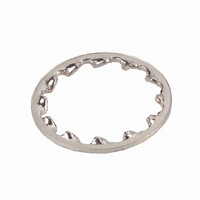H-37-2 Bourns Inc., H-37-2 Datasheet - Page 29

H-37-2
Manufacturer Part Number
H-37-2
Description
HDWR LOCKWASHER FOR ECW ENCODER
Manufacturer
Bourns Inc.
Specifications of H-37-2
Product
Lock Washer
Lead Free Status / RoHS Status
Lead free / RoHS Compliant
For Use With
ECW1DB24BC0024 - ENCODER DIGITAL CONT 24 CPRECW1JB24BC0024 - ENCODER DIGITAL CONT 24 CPR
Lead Free Status / Rohs Status
Lead free / RoHS Compliant
28
Application Notes
Temperature Coefficient of Resistance
The temperature coefficient of resistance (TCR) is an
indication of the maximum change in total
resistance that may occur due to a change in ambient
operating temperature. This parameter is normally
specified in parts per million per degree Celsius
(PPM/°C). Temperature coefficient is dependent on
the type of material used to construct the resistive
element and the physical structure of the unit.
Potentiometers constructed with cermet, conductive
plastic or carbon elements typically have a higher
temperature coefficient than those constructed with
wirewound elements by approximately twice the
value.
Wiper Load
The wiper load must always be specified carefully, as
it has a great effect on the wiper output. Unless
otherwise specified, Bourns assumes the resistance
wiper load to be at least 100 times the value of the
potentiometer per the industry standard. In
specifying the wiper load, keep in mind that if the
current load is too high, linearity will degrade. With
conductive plastic elements, excessive wiper load will
increase the negative effects of contact resistance and
Figure 2: Error Due to Wiper Loading
contact resistance variation (CRV). The rule of
thumb for selecting the wiper load is to use the ratio
of total resistance (RT) to wiper load (RL) of 1:100
or higher (see Figures 2 and 3.)
The following tables will guide you in selecting the
correct type of potentiometer for your application.
Figure 3: Linearity Affected by Load


















